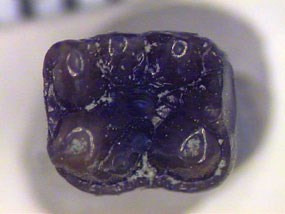
Primate Molar Emerges From Fossil Beds 1/24/98-J. Chapman, JODA Staff Evidence of the last known primate to inhabit North America prior to humans has recently surfaced among the field collections from the 1997 fossil prospecting season at John Day Fossil Beds National Monument. In December, while cataloging the summer's finds, fossil preparator Kelly Cahill came across a strange molar, unlike any in the monument's museum collection. Monument paleontologist Ted Fremd identified the 4mm specimen as a lower molar belonging to Ekgmowechashala (IG-a-moo-we-CHA-sha-la), a small, ancient, lemur-like animal which is extremely rare in the fossil record. "All of us have been looking for something like this for years," Fremd said. The genus Ekgmowechashala is classified in the order Primates, sub-order Dermoptera (flying-lemurs), and has a tooth structure similar to flying squirrels. A jaw fragment with adjacent upper molars (intact M1-M2, broken M3) from the same kind of animal was previously known from the region, discovered in 1961. A cast of this specimen was used to positively identify the newly found molar (lower m2) which "fit like a glove," according to Fremd. The recent find is important because it includes good documentation of the stratigraphic position of the fossil. Knowing where the fossil was located in the rock allows a date of 25 million years ago to be assigned to it. Other specimens of Ekgmowechashala from South Dakota had been dated at 28 million years ago and were considered to mark the end of the original primate lineage in North America. The John Day find confirms that ancient primates were in Oregon 3 million years after scientists thought they had become extinct. The newest molar was collected by John Zancanella of the Bureau of Land Management who was part of an interagency team doing routine prospecting in the fossil beds. "We try to continuously examine fossil-bearing rocks to collect scientifically significant fossils on federal lands," stated Fremd. "Otherwise, weathering and other factors may destroy them." Fremd plans to return with the field crew next summer to the area where the molar was found in hopes of recovering more evidence of North America's last primate. |
Last updated: February 28, 2015
